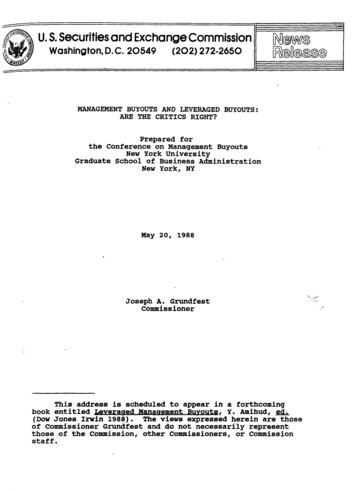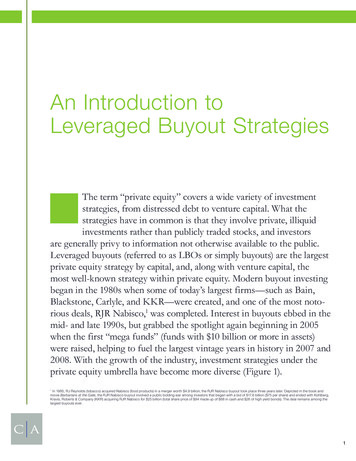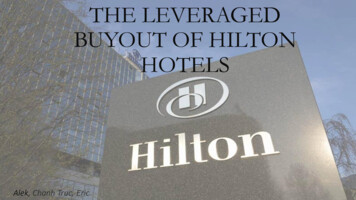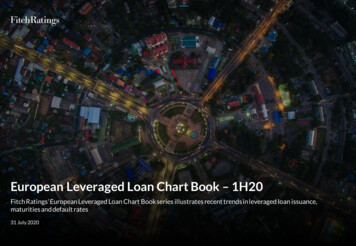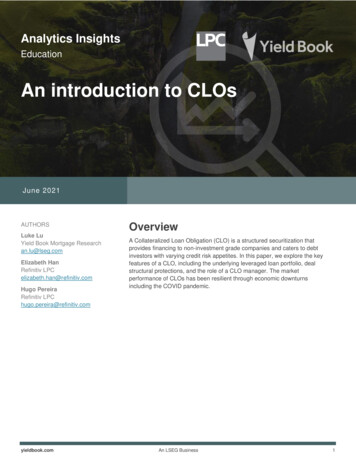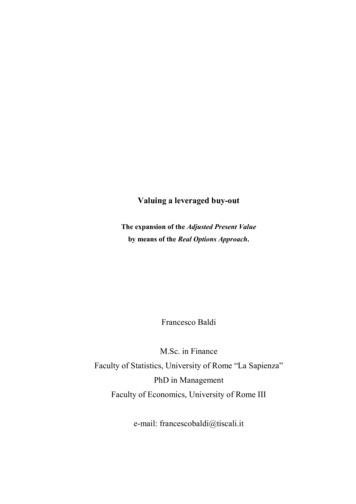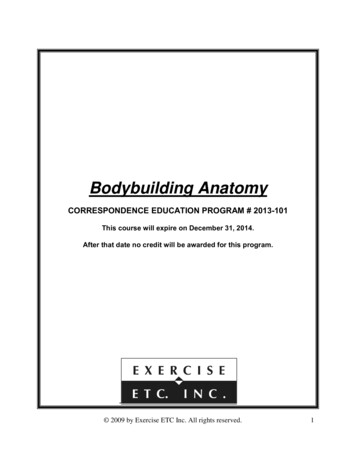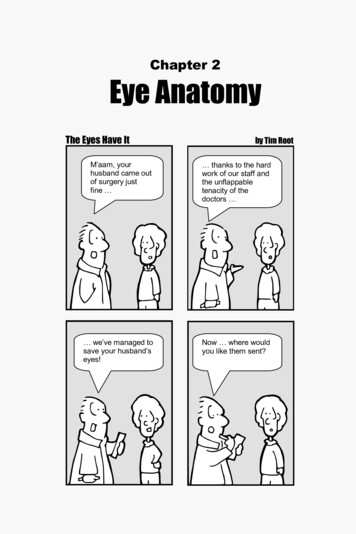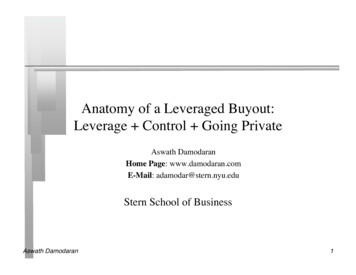
Transcription
Anatomy of a Leveraged Buyout:Leverage Control Going PrivateAswath DamodaranHome Page: www.damodaran.comE-Mail: adamodar@stern.nyu.eduStern School of BusinessAswath Damodaran1
Leveraged Buyouts: The Three Possible ComponentsIncrease financial leverage/ debtLeverageControlLeveraged BuyoutTake the companyprivate or quasiprivateChange the waythe company isrun (often withexistingmanagers)Public/ PrivateAswath Damodaran2
One Example: The Harman DealPre-dealHarmanPost-dealHarmanDebt 4 billionDebt (mostlyleases) 274Publliclytradedequity 5.5 billionKKR & Goldman wouldbuy out existing equityinvestorsFirm will become aquasi-privatecompany with 75%of the equity held byKKR, Goldman andmanagers.KKR,Goldman &Managers 3 billionPublic 1 billionAswath Damodaran3
Issues in valuing leveraged buyouts Given that there are three significant changes - an increase in financialleverage, a change in control/management at the firm and a transition frompublic to private status - what are the valuation consequences of each one?Are there correlations across the three? In other words, is the value of financialleverage increased or decreased by the fact that control is changing at the sametime? How does going private alter the way we view the first two?Given that you are not required to incorporate all three in a transaction, whendoes it make sense to do a leveraged buyout? How about just a buyout? Howabout just going for a change in control? Just a change in leverage?Aswath Damodaran4
I. Value and LeverageAswath Damodaran5
What is debt. General Rule: Debt generally has the following characteristics: Commitment to make fixed payments in the futureThe fixed payments are tax deductibleFailure to make the payments can lead to either default or loss of control of the firmto the party to whom payments are due.Using this principle, you should include the following in debt Aswath DamodaranAll interest bearing debt, short as well as long termAll lease commitments, operating aas well as capital6
The fundamental question: Does the mix of debt and equityaffect the value of a business?AssetsExisting InvestmentsGenerate cashflows todayIncludes long lived (fixed) andshort-lived(workingcapital) assetsExpected Value that will becreated by future investmentsDifferent Value?Aswath DamodaranLiabilitiesAssets in PlaceDebtGrowth AssetsEquityFixed Claim on cash flowsLittle or No role in managementFixed MaturityTax DeductibleResidual Claim on cash flowsSignificant Role in managementPerpetual LivesDifferent Financing Mix?7
A basic proposition about debt and value For debt to affect value, there have to be tangible benefits and costs associatedwith using debt instead of equity. Aswath DamodaranIf the benefits exceed the costs, there will be a gain in value to equity investorsfrom the use of debt.If the benefits exactly offset the costs, debt will not affect valueIf the benefits are less than the costs, increasing debt will lower value8
Debt: The Basic Trade OffAdvantages of BorrowingDisadvantages of Borrowing1. Tax Benefit:1. Bankruptcy Cost:Higher tax rates -- Higher tax benefitHigher business risk -- Higher Cost2. Added Discipline:2. Agency Cost:Greater the separation between managersGreater the separation between stock-and stockholders -- Greater the benefitholders & lenders -- Higher Cost3. Loss of Future Financing Flexibility:Greater the uncertainty about futurefinancing needs -- Higher CostAswath Damodaran9
A Hypothetical Scenario(a) There are no taxes(b) Managers have stockholder interests at hear and do what’s best forstockholders.(c) No firm ever goes bankrupt(d) Equity investors are honest with lenders; there is no subterfuge or attempt tofind loopholes in loan agreements(e) Firms know their future financing needs with certaintyWhat happens to the trade off between debt and equity? How much should a firmborrow?Aswath Damodaran10
The Miller-Modigliani Theorem In an environment, where there are no taxes, default risk or agency costs,capital structure is irrelevant.The value of a firm is independent of its debt ratio and the cost of capital willremain unchanged as the leverage changes.Aswath Damodaran11
But here is the real world In a world with taxes, default risk and agency costs, it is no longer true thatdebt and value are unrelated.In fact, increasing debt can increase the value of some firms and reduce thevalue of others.For the same firm, debt can increase value up to a point and decrease valuebeyond that point.Aswath Damodaran12
Tools for assessing the effects of debt The Cost of Capital Approach: The optimal debt ratio is the one thatminimizes the cost of capital for a firm.The Enhanced Cost of Capital Approach: The optimal debt ratio is the one thatcreates a combination of cash flows and cost of capital that maximizes firmvalue.The Adjusted Present Value Approach: The optimal debt ratio is the one thatmaximizes the overall value of the firm.Aswath Damodaran13
a. The Cost of Capital ApproachOperating Cash flow is assumed to be unaffected by changing debt ratiot "Free Cash Flow to the FirmtValue of Firm #t(1 CostofCapital)t 1!If changing the debt ratio changes the cost of capital,the optimal debt ratio is the one that minimizes thecost of capital.Aswath Damodaran14
How the debt trade off manifests itself in the cost ofcapital Bankruptcy costs are built into both thecost of equity the pre-taxcost of debtTax benefit ishereCost of capital Cost of Equity (Equity/ (Debt Equity)) Pre-tax cost of debt (1- tax rate) (Debt/ (Debt Equity)As you borrow more, heequity in the firm willbecome more risky asfinancial leverage magnifiesbusiness risk. The cost ofequity will increaseAswath DamodaranAs you borrow more,your default risk as afirm will increasepushing up your costof debt.At some level ofborrowing, your taxbenefits may be putat risk, leading to alower tax rate.15
The mechanics of cost of capital computation.Cost of Equity Rf Beta (Equity Risk Premium)Pre-tax cost of debt Rf Defautl sprreadStart with the beta of the business (asset orunlevered beta)Estimate the interest expense at each debt levelAs the firm borrows more, recompute thedebt to equity ratio (D/E) .Compute an interest coverage ratio based on expenseInterest coverage ratio Operating income/ Interest expenseCompute a levered beta based on this debt toequity ratioLevered beta Unlevered beta (1 (1-t) (D./E))Estimate a synthetic rating at each level of debtUse the rating to come up with a default spread, which whenadded to the riskfree rate should yield the pre-tax cost of debtEstimate the cost of equity based on the leveredbetaAswath Damodaran16
Harman : Working out the mechanics.Asset or unlevered beta 1.45Debt 1.832.052.393.064.086.1212.98Cost of .82%28.98%56.40%Marginal tax rate 38%Bond RatingAAAAAAABBBCCCCCDInterest rate on .50%24.50%Tax 6%19.48%11.66%Cost of Debt 0%14.02%15.22%16.42%25.12%Firm Value (G) 5,660 6,063 6,443 6,485 5,740 4,507 3,342 2,938 2,616 1,401As the cost of capital decreases, the firm value increases.The change in firm value is computed based upon thechange in the cost of capital and a perpetual growth rate.The optimal debt ratio for Harman Audio is about 30% ofoverall firm value. In September 2007, the overall firm value(debt equity) was about 6 billion, yielding an optimal dollardebt of approximately 1.8 billion.Aswath Damodaran17
Harman’s existing debt The market value of interest bearing debt can be estimated: In September 2007, Harman had book value of debt of 76.5 million, interest expenses of 9.6million, a current cost of borrowingand# of 4.85%& an weighted average maturity of 4 years.1Estimated MV of Harman Debt % (1" (1.0485) 4 (76.59.6% 97 million( 4.0485(1.0485)%( Harman has lease commitments stretchinginto'the futureYearCommitmentPresent Value1 43.50 41.49!2 40.90 37.203 38.50 33.404 23.90 19.785 19.20 15.156-? 31.45 126.58Debt Value of leases 273.60 Debt outstanding at Harman 97 274 371 millionAswath Damodaran18
Limitations of the Cost of Capital approach It is static: The most critical number in the entire analysis is the operatingincome. If that changes, the optimal debt raito will change.It ignores indirect bankruptcy costs: The operating income is assumed to stayfixed as the debt ratio and the rating changes.Beta and Ratings: It is based upon rigid assumptions of how market risk anddefault risk get borne as the firm borrows more money and the resulting costs.Aswath Damodaran19
b. Enhanced Cost of Capital Approach Distress cost affected operating income: In the enhanced cost of capitalapproach, the indirect costs of bankruptcy are built into the expected operatingincome. As the rating of the firm declines, the operating income is adjusted toreflect the loss in operating income that will occur when customers, suppliersand investors react.Dynamic analysis: Rather than look at a single number for operating income,you can draw from a distribution of operating income (thus allowing fordifferent outcomes).Aswath Damodaran20
Estimating the Distress Effect- HarmanRatingA or higherABBBBB BBB BBCCCCCCDAswath DamodaranDrop in EBITDANo 0%40.00%40.00%50.00%Indirect bankruptcy costsmanifest themselves whenthe rating drops to A andthen start becoming largeras the rating drops belowinvestment grade.21
The Optimal Debt Ratio with Indirect Bankruptcy CostsDebt 1.922.332.803.494.666.9913.98Cost of .14%32.46%60.42%Bond RatingAAAAAAACDDDDDDInterest rate on 4.50%24.50%Tax 47%3.98%Cost of Debt 19.21%21.21%23.21%25.21%27.21%Firm Value (G) 5,549 6,141 6,480 1,276 365 308 266 234 209 189Optimal debt ratio is at 20% ( 1.2 billion). Beyond 20%,the operating income effect will overwhelm any potentialtax benefits.Aswath Damodaran22
c. The APV Approach to Optimal Capital Structure In the adjusted present value approach, the value of the firm is written as thesum of the value of the firm without debt (the unlevered firm) and the effect ofdebt on firm valueFirm Value Unlevered Firm Value (Tax Benefits of Debt - ExpectedBankruptcy Cost from the Debt)The optimal dollar debt level is the one that maximizes firm valueAswath Damodaran23
Implementing the APV Approach Step 1: Estimate the unlevered firm value. This can be done in one of two ways:1. Estimating the unlevered beta, a cost of equity based upon the unlevered beta andvaluing the firm using this cost of equity (which will also be the cost of capital,with an unlevered firm)2. Alternatively, Unlevered Firm Value Current Market Value of Firm - TaxBenefits of Debt (Current) Expected Bankruptcy cost from DebtStep 2: Estimate the tax benefits at different levels of debt. The simplest assumption tomake is that the savings are perpetual, in which case Tax benefits Dollar Debt * Tax RateStep 3: Estimate a probability of bankruptcy at each debt level, and multiply by the costof bankruptcy (including both direct and indirect costs) to estimate the expectedbankruptcy cost.Aswath Damodaran24
Harman: APV at Debt RatiosBased uponsynthetic ratingDebt Ratio0%10%20%30%40%50%60%70%80%90% Debt 0 563 1,127 1,690 2,253 2,817 3,380 3,943 4,506 5,070Tax 0%13.30%11.82%Unlevered Firm ValueTax Benefits 5,596 0 5,596 214 5,596 428 5,596 642 5,596 856 5,596 1,013 5,596 599 5,596 599 5,596 599 5,596 599Bond RatingAAAAAAAB CCCCDDDDBankruptcy costestimated to be25% of firm valueProbability of DefaultExpected BankruptcyValueCostof Levered Firm0.01% 0 5,5960.01% 0 5,8100.53% 8 6,01619.28% 301 5,93865.00% 1,049 5,40465.00% 1,074 5,535100.00% 1,549 4,647100.00% 1,549 4,647100.00% 1,549 4,647100.00% 1,549 4,647Based on the adjusted present value model, the optimaldollar debt level at Harman is 1.12 billion. The firmvalue is maximized at that pointAswath Damodaran25
The “key” determinants of debt capacity are tax rates andcash flows In all three approaches, the capacity of a firm to borrow money is determinedby its cash flows, not its market value or growth prospects. The greater the cash flows generated are as a percent of enterprise value, the higherthe optimal debt ratio of a firm.The more stable and predictable these cash flows are, the higher the optimal debtratio of a firm.The most significant benefit of debt is a tax benefit. Higher tax rates shouldlead to higher debt ratios. With a zero tax rate the optimal debt ratio will bezero.Implication: Mature or declining firms in businesses that generate high andpredictable cash flows will be the best candidates for financial leverage. Does Harman pass the test?Aswath Damodaran26
The macro environment has a relatively small effect onoptimal debt ratios Myth 1: Optimal debt ratios will increase as interest rates decline. While it istrue that lower interest rates push down the cost of debt, they also push downthe cost of equity.Myth 2: Optimal debt ratios will increase as default spreads decline. Defaultspreads have historically declined in buoyant markets, which also push equityrisk premiums down. In other words, both the cost of debt and equity becomecheaper.Aswath Damodaran27
But bond markets and equity markets sometime deviate Aswath Damodaran28
II. The Value of ControlAswath Damodaran29
Why control matters When valuing a firm, the value of control is often a key factor isdetermining value.For instance, In acquisitions, acquirers often pay a premium for control that can besubstantial When buying shares in a publicly traded company, investors often pay apremium for voting shares because it gives them a stake in control.\ In private companies, there is often a discount atteched to buying minoritystakes in companies because of the absence of control.Aswath Damodaran30
What is the value of control? The value of controlling a firm derives from the fact that you believe that youor someone else would operate the firm differently (and better) from the way itis operated currently.The expected value of control is the product of two variables: Aswath Damodaranthe change in value from changing the way a firm is operatedthe probability that this change will occur31
The determinants of valueDISCOUNTED CASHFLOW VALUATIONExpected GrowthFirm: Growth inOperating EarningsEquity: Growth inNet Income/EPSCash flowsFirm: Pre-debt cashflowEquity: After debtcash flowsFirm is in stable growth:Grows at constant rateforeverTerminal ValueValueFirm: Value of FirmEquity: Value of EquityCF1CF2CF3CF4CF5CFn.ForeverLength of Period of High GrowthDiscount RateFirm:Cost of CapitalEquity: Cost of EquityAswath Damodaran32
Harman: Status QuoReinvestment Rate42.00%Current Cashflow to FirmEBIT(1-t) :248- Nt CpX67- Chg WC37 FCFF144Reinvestment Rate 104/248 42%Return on Capital14.56%Expected Growthin EBIT (1-t).42*.1456 .06136.13%Stable Growthg 4%; Beta 1.00;Cost of capital 7.40%ROC 12%; Tax rate 38%Reinvestment Rate 33.33%Terminal Value5 231(.074-.04) 6799Op. Assets4,886 Cash:106- Debt350 Equity4,641-Options119Value/Share 69.32YearEBIT (1-t)- ReinvestmentFCFF1 263 111 1522 279 117 1623 296 125 1724 314 132 1825 334 140 193Term Yr346.9115.6231.3Discount atCost of Capital (WACC) 10.34% (.94) 3.01% (0.06) 9.91%Cost of Equity10.34%Riskfree Rate:Riskfree rate 4.5%Cost of Debt(4.5% % .35%)(1-.38) 3.01% Beta1.46Unlevered Beta forSectors: 1.43Aswath DamodaranWeightsE 94%% D 6%XRisk Premium4%Firm!s D/ERatio: 6%Mature riskpremium4%CountryEquity Prem0.%33
Increase Cash FlowsMore efficientoperations andcost cuttting:Higher MarginsReduce the cost of capitalMake yourproduct/service lessdiscretionaryRevenues* Operating MarginReduce beta EBITDivest assets thathave negative EBITReduce tax rate- moving income to lower tax locales- transfer pricing- risk managementReduceOperatingleverage- Tax Rate * EBIT EBIT (1-t) Depreciation- Capital Expenditures- Chg in Working Capital FCFFLive off past overinvestmentCost of Equity * (Equity/Capital) Pre-tax Cost of Debt (1- tax rate) *(Debt/Capital)Match your financingto your assets:Reduce your defaultrisk and cost of debtShift interestexpenses tohigher tax localesChange financingmix to reducecost of capitalBetter inventorymanagement andtighter credit policiesFirm ValueIncrease Expected GrowthReinvest more inprojectsIncrease operatingmarginsAswath DamodaranIncrease length of growth periodDo acquisitionsReinvestment Rate* Return on CapitalIncrease capital turnover ratioBuild on existingcompetitiveadvantagesCreate newcompetitiveadvantages Expected Growth Rate34
Harman: RestructuredReinvestment Rate70.00%Current Cashflow to FirmEBIT(1-t) :248- Nt CpX67- Chg WC37 FCFF144Reinvestment Rate 104/248 42%Return on Capital15%Expected Growthin EBIT (1-t).70*.15 .10510.5%Stable Growthg 4%; Beta 1.00;Cost of capital 7.48%ROC 12%; Tax rate 38%Reinvestment Rate 33.33%Terminal Value5 284(.074-.04) 8155Op. Assets5588 Cash:106- Debt350 Equity5,325-Options119Value/Share 80.22YearEBIT (1-t)- ReinvestmentFCFF1 274.7 192.3 82.42 303.5 212.5 91.13 335.4 234.8 100.64 370.6 259.4 111.25 409.6 286.7 122.9Term Yr425.9141.9284.0Discount atCost of Capital (WACC) 10.90% (.80) 3.41% (0.20) 9.40%Cost of Equity10.90%Riskfree Rate:Riskfree rate 4.5%Cost of Debt(4.5% % 1%)(1-.38) 3.41% Beta1.60Unlevered Beta forSectors: 1.43Aswath DamodaranWeightsE 80%% D 20%XRisk Premium4%Firm!s D/ERatio: 25%Mature riskpremium4%CountryEquity Prem0.%35
Mechanisms for control Put pressure on existing managers to change their ways: With activistinvesting and proxy contests, you can try to put pressure on existing managersto change their ways. Change the managers of the company: The board of directors, in exceptionalcases, can force out the CEO of a company and change top management. Pluses: Relatively low costMinuses: Managers may be entrenchedPluses: Disruptions minimizesMinuses: Board has to be activist and has to pick a good successorAcquisitions: If internal processes for management change fail, stockholdershave to hope that another firm or outside investor will try to take over the firm(and change its management).Aswath Damodaran36
Implications for the control premiuma. The value of control will vary across firms: Since the control premium is thedifference between the status-quo value of a firm and its optimal value, itfollows that the premium should be larger for poorly managed firms andsmaller for well managed firms.b. There can be no rule of thumb on control premium: Since control premium willvary across firms, there can be no simple rule of thumb that applies across allfirms. The notion that control is always 20-30% of value cannot be right.c. The control premium should vary depending upon why a firm is performingbadly: The control premium should be higher when a firm is performing badlybecause of poor management decisions than when a firm’s problems arecaused by external factors over which management has limited or no control.d. The control premium should be a function of the ease of making managementchanges: It is far easier to change the financing mix of an under leveredcompany than it is to modernize the plant and equipment of a manufacturingcompany with old and outdated plants.Aswath Damodaran37
The perfect “control” target If control is the motive for an acquisition, the target firm should possess thefollowing characteristics: Its stock has underperformed the sector and the marketIts margins are lower than the sector with no offsetting benefits (higher turnoverratios, for instance)Its returns on equity and capital lag its costs of equity and capitalThe fault lies within the company and can be fixedDoes Harman pass the test? Aswath DamodaranIts operating margin is about 11%; the average for the sector is 8%.Its return on capital is about 15%; its cost of capital is less than 10%;Its stock has earned roughly similar returns as the rest of the sector38
III. The Public/ Private TransitionAswath Damodaran39
Why go public? To raise capital: It is true that private companies have access to new sources ofcapital (private equity, venture capital) that might not have been accessibledecades ago, but it is usually less expensive to raise equity in public marketsthan from private hands.To monetize value: Even if a private firm is valuable, the value is anabstraction. Being traded puts a “price” on the company, allowing its ownersto get both bragging rights and financial advantages.To bear risk more efficiently : Much of the risk in any business is firm-specificand diversifiable. Private business owners are often invested primarily or onlyin their businesses. The marginal investors in a public company are morelikely to be diversified and price the business based on the risks that theyperceive.Aswath Damodaran40
Perceived Risk: Private versus PublicPrivate Owner versus Publicly Traded Company Perceptions of Risk in an InvestmentTotal Beta measures all risk Market Beta/ (Portion of thetotal risk that is market risk)Is exposedto all the riskin the firm80 unitsof firmspecificriskPrivate owner of businesswith 100% of your weatlthinvested in the businessMarket Beta measures justmarket riskDemands acost of equitythat reflects thisriskEliminates firmspecific risk inportfolio20 unitsof marketriskPublicly traded companywith investors who are diversifiedDemands acost of equitythat reflects onlymarket riskAswath Damodaran41
Implications for valuation In estimating the cost of equity for a publicly traded firm, we use the marketbeta (or betas) to come up with the cost of equity. Implicitly, we are assumingthat the firm-specific risk will be diversified away and not affect the cost ofequity. For a private business owner, this reasoning is flawed. If he or she iscompletely invested only in this business, the beta has to reflect total risk andnot just market risk.Total Beta Market Beta/ Correlation of business with market Using this approach for Harman, we arrive at the following:Valued asBetaCost of capitalEstimated Value of BusinessPublic firm1.469.91% 4.9 billionPrivate business2.9715.6% 2.4 billion Aswath Damodaran42
Why go private? Agency issues: The managers at a publicly traded company may have littleincentive to do what’s best for the company because it is the stockholders’money that they are playing with.Disclosure costs: Publicly traded firms have to meet far more disclosurerequirements (FASB, Sarbanes Oxley, SEC) etc. Not only does it cost moneyto comply but competitors may be getting valuable information on strategiesand products.Time horizon: To the extent that publicly traded firms are at the mercy of theshort term whims of analysts and investors, going private may allow thesefirms to make decisions that are best for the long term.Public pressure: It is easier to bring public pressure on a publicly traded firm(through regulators, investors etc.) than on a private business.Aswath Damodaran43
Minimizing the privatizing cost. The cost of going private (in terms of inefficient risk bearing) is far too largefor it to make sense for a publicly traded firm to go private permanently intothe hands of a single owner.The cost of bearing risk inefficiently can be reduced by Having a portfolio of private businesses (The KKR solution); this increases thecorrelation with the market and lowers total beta.Going private temporarily (with the intent of going public again); this will result inthe higher cost of capital being applied only for the expected “going private’period.Even with these actions, there is a significant residual risk borne by privateequity investors. That risk can be eliminated by the private equity investorsitself going public. (the Blackstone solution)Aswath Damodaran44
Good candidates for going private. Assuming that you are planning to take a company private temporarily and aspart of a portfolio of such investments, the best candidates for going privatewould be companies that have the following characteristics: Top managers are not significant stockholders in the firmThe actions that the firm needs to take to fix its problems are likely to be painful inthe short term. The pain will be reflected in lower earnings and potentially inactions that create social backlash (layoffs, factory shutdowns )Analysts following the company are not giving it credit for long term actions andfocusing primarily on earnings in the near term.Does Harman pass the test?Aswath Damodaran45
IV. Interactions and Conclusion.Aswath Damodaran46
Leverage and ControlThe good: A firm that is restructuring to fix its operating problems is likely tobecome healthier and be more likely to pay off its debt obligations. In practicalterms, the default risk in this firm decreases because of the possibility ofrestructuring. The bad: Firms that restructure are changing themselves on multipledimensions - business mix, cash flows and assets. Lenders who do not monitorthe process may very well find the assets that secure their loans eliminatedfrom under them and be left holding the bag. The equity investors who controlthe busisiness can also direct cashflows into their own pockets (managementfees )Implication: Lenders in leveraged buyouts need to take an active role in therestructuring process and should demand an equity stake in the business. Aswath Damodaran47
Control and Going PrivateThe Good: Since the managers of the business are now the owners, they arelikely to become much more aware of default risk and distress (since it is theirwealth at play) and be less likely to be overly aggressive risk takers. The Bad: If things start going bad and the managers decide that they have littleto lose, they will start taking not just more risks but imprudent risks. In effect,their equity positions have become options and more risk makes them morevaluable.Implication: Lenders have to step in much sooner and more aggressively, if firmsget into trouble. Letting managers/owners make decisions in their firms canprovide a license to steal. It follows that lending should be restricted tobusinesses with transparent and easily understood operations. Aswath Damodaran48
Leverage and Going PrivateThe Good: You could make the owners of the company personally liable forthe loans taken by the company. That increases your security and reducesdefault costs. The Bad: Their lawyers are likely to be more creative and inventive than yourlawyers. Assets and cash mysteriously find nooks and crannies to hide Implication: Hot deals, where borrowers set the terms, are unlikely to be gooddeals for lenders. Aswath Damodaran49
The bottom line Each of the three components in an LBO - changing leverage, acquiringcontrol and going private - has effects on value but the effects can be positiveor negative.The components are separable. There are some firms that are good candidatesfor leveraged recaps (the L in the LBO), others that are ripe for a hostileacquisition (the B in the LBO) and still others that may benefit from a shortperiod out of the public limelight (the O in the LBO). There may even be afew that are ready for two out of the three components .The list of firms thatare right for all three components at the same time is likely to be a very shortone.Aswath Damodaran50
Leveraged Buyout Leverage Control Public/ Private. Aswath Damodaran 3 One Example: The Harman Deal Pre-deal Harman Publlicly traded equity Debt (mostly leases) 274 5.5 billion Post-deal . In September 2007, Harman had book value of debt of 76.5 million, interest expenses of 9.6File Size: 2MBPage Count: 50
